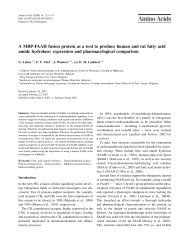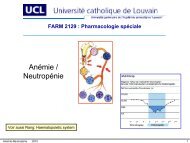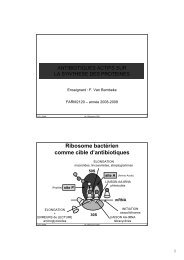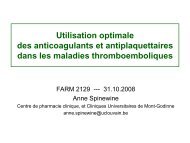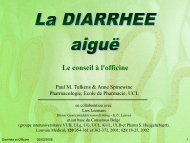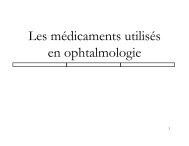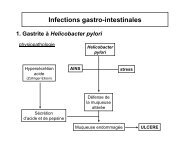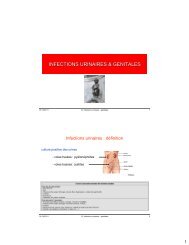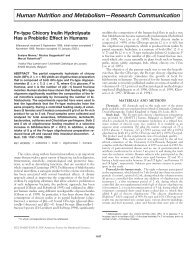Role of apoptosis for mouse liver growth regulation and tumor ...
Role of apoptosis for mouse liver growth regulation and tumor ...
Role of apoptosis for mouse liver growth regulation and tumor ...
You also want an ePaper? Increase the reach of your titles
YUMPU automatically turns print PDFs into web optimized ePapers that Google loves.
30 W. Bursch et al. / Toxicology Letters 149 (2004) 25–35<br />
suggesting pr<strong>of</strong>ound differences in <strong>apoptosis</strong> control<br />
in <strong>mouse</strong> as opposed to rat <strong>liver</strong>.<br />
3. Cell birth <strong>and</strong> cell death in putative<br />
preneoplastic lesions, adenoma <strong>and</strong> carcinoma <strong>of</strong><br />
<strong>mouse</strong> <strong>liver</strong> (long-term study)<br />
3.1. Formation <strong>of</strong> <strong>liver</strong> <strong>tumor</strong>s<br />
Twenty weeks after a single dose <strong>of</strong> N-nitrosodiethylamine<br />
(NDEA), with or without subsequent<br />
PB-treatment, neither C57Bl/6J nor C3H/He developed<br />
macroscopically visible lesions (not shown). At<br />
40 weeks <strong>of</strong> the experimental period, a low <strong>tumor</strong> incidence<br />
was found in “NDEA → PB (38w)” treated<br />
C57Bl/6J animals, followed by gradual increase until<br />
74 weeks <strong>of</strong> PB treatment (Table 4). In contrast, at<br />
40 weeks <strong>of</strong> the experiment “NDEA → PB (38w)”<br />
treated C3H/He mice exhibited already a high number<br />
<strong>of</strong> <strong>tumor</strong>s (Table 4); C3H/He mice treated with<br />
either NDEA or PB alone developed <strong>liver</strong> <strong>tumor</strong>s as<br />
well, but more slowly <strong>and</strong> to a lesser extent (Table 4).<br />
Furthermore, at 40 <strong>and</strong> 76 weeks <strong>of</strong> the experiment<br />
C3H/He mice in general exhibited a significantly<br />
higher <strong>liver</strong> <strong>tumor</strong> incidence than C57Bl/6J animals.<br />
In fact, because <strong>of</strong> the high <strong>liver</strong> <strong>tumor</strong> incidence<br />
“NDEA → PB” treated C3H/He mice could not be<br />
assigned <strong>for</strong> later time points <strong>of</strong> the study. These results<br />
confirmed the known interstrain differences between<br />
C3H/He <strong>and</strong> C57Bl/6J mice (<strong>for</strong> review: Gold<br />
et al., 2001; Fausto, 1999). Furthermore, according to<br />
histopathological criteria the macroscopically visible<br />
lesions were classified as either hepatocellular adenoma<br />
(HCA) or carcinoma (HCC)—(1) the majority<br />
revealed to be HCA (C57Bl/6J: 89%, C3H/He: 64%),<br />
(2) these data also indicate that progression from HCA<br />
to HCC occurs more readily in C3H/He (36% HCC)<br />
than in C57Bl/6J-mice (11% HCC). Likewise, the<br />
conversion rate <strong>of</strong> foci into <strong>tumor</strong>s has been found to<br />
correlate with <strong>mouse</strong> strain susceptibility to hepatocarcinogenesis<br />
(Goldsworthy <strong>and</strong> Fransson-Steen, 2002).<br />
3.2. Cell birth <strong>and</strong> cell death in PPF, HCA <strong>and</strong> HCC<br />
Putative preneoplastic lesions (PPF) were diagnosed<br />
in HE-stained <strong>liver</strong> sections according to published<br />
criteria (Bannasch <strong>and</strong> Gössner, 1994; Hanigan et al.,<br />
Table 4<br />
Mouse <strong>liver</strong> <strong>tumor</strong> incidence in C57Bl/6J <strong>and</strong> C3H/He mice<br />
Strain/treatment n Number <strong>of</strong> <strong>tumor</strong>s/animal<br />
C57Bl/6J<br />
0 → 0<br />
(50w) 6 0.2 ± 0.4<br />
(74w)<br />
NDEA → 0<br />
4 0.3 ± 0.5<br />
(38w) 7 0.3 ± 0.8<br />
(50w) 8 1.6 ± 1.2<br />
(74w)<br />
0 → PB<br />
12 1.7 ± 1.7<br />
(50w) 6 0<br />
(74w)<br />
NDEA → PB<br />
4 0<br />
(38w) 5 0.1 ± 0.4<br />
(50w) 8 2.5 ± 3.6<br />
(74w) 12 5.2 ± 3.8a C3H/He<br />
0 → 0<br />
(50w) 6 0.7 ± 0.8<br />
(74w)<br />
NDEA → 0<br />
6 0.6 ± 0.6<br />
(38w) 6 2.6 ± 1.9<br />
(50w) 8 6.0 ± 2.0<br />
(74w) 12 7.6 ± 2.8bb 0 → PB<br />
(50w) 6 0.5 ± 1.2<br />
(74w)<br />
NDEA → PB<br />
4 2.7 ± 1.9<br />
(38w) 7 9.3 ± 2.5c (50w) 11 9.1 ± 2.2d Male C57Bl/6J <strong>and</strong> C3H/He (specific pathogen free; purchased from<br />
the Institut für Labortierkunde und –genetik (Himberg, Austria) were<br />
housed individually in Macrolon cages on st<strong>and</strong>ard s<strong>of</strong>twood bedding<br />
(Altromin, Lage, Germany) under st<strong>and</strong>ardized environmental conditions<br />
<strong>and</strong> an inverted 12 h light–dark rhythm with light from 10 p.m. to 10<br />
a.m. <strong>and</strong> dark from 10 a.m. to 10 p.m. Food (Altromin 1321 N) <strong>and</strong><br />
tap water were provided ad libitum. Body weight <strong>and</strong> food consumption<br />
were recorded weekly. 5-weeks-old mice received a single intraperitoneal<br />
injection <strong>of</strong> N-nitrosodiethylamine (NDEA). 90 mg/kg <strong>of</strong> body weight<br />
(NDEA obtained from Sigma-Aldrich, Wien, Austria), freshly dissolved in<br />
sterile 0.9% saline (20 ml/kg <strong>of</strong> b.w.). After 2 weeks <strong>of</strong> recovery, mice were<br />
fed either st<strong>and</strong>ard diet (“NDEA → 0”) or a diet containing phenobarbital<br />
(5-ethyl-5-phenyl-barbituric acid, (PB; Fluka Chemie, Buchs, Switzerl<strong>and</strong>)<br />
<strong>for</strong> up to 90 weeks (“NDEA → PB”). Other groups <strong>of</strong> animals received<br />
PB alone (“0 → PB”) or no treatment at all (control “0 → 0”). The PB<br />
concentration in the diet was adjusted in the range <strong>of</strong> 0.05%–0.07% to<br />
provide a constant daily intake <strong>of</strong> 90 mg PB/kg b.w. Mean number <strong>of</strong><br />
macroscopically visible <strong>tumor</strong>s per animal (±S.D.) are given. number <strong>of</strong><br />
animals are given at the bottom. For statistical comparisons the two-tailed<br />
Mann–Whitney-test (non-parametric statistic test procedure) was used.<br />
a P



